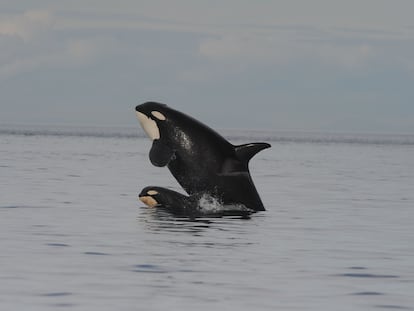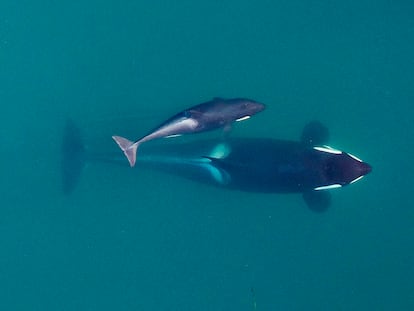The biography of Gladys, the killer whale who breaks sailboats and reigns supreme on social media
The cetacean has become famous on the internet for the damage it has caused to boats off the Spanish coast. But it is not just one animal behaving this way but 15, and not everything that is said about them is true
Gladys the killer whale exists, but she isn’t just one orca; there are 15 of them. The one who has become famous on the internet recently, giving rise to all kinds of memes and posts, for causing damage and even sinking yachts off the Spanish coast, is actually the one that scientists call white Gladys, the oldest (and only adult) of the group. But in the same community, there are juvenile specimens such as grey Gladys, black Gladys, small Gladys... For about three years, these animals have engaged in very unusual behavior with boats, sometimes causing significant damage in the process. Scientists point to different hypotheses to explain why killer whales are ramming boats. But there is no certainty that white Gladys is teaching the younger specimens to hit the boats because of an alleged trauma stemming from a past collision, despite viral posts implying that is the case. In fact, researchers do not know how to explain the attitude of these killer whales. Scientists believe that the orcas learned this behavior through their curiosity and playfulness. That is the extent of what science knows about this peculiar group of cetaceans that are suddenly all the rage on social media.
The slew of memes on social media has contributed to amplifying the image of the orca as a murderous and vengeful whale that intentionally attacks boats to cause harm. But experts say that this interpretation is quite far from reality. The history of killer whale attacks is recent, dating back to May 2020, when the first documented interaction of one of these cetaceans (Orcinus orca) with a ship occurred in the Strait of Gibraltar. A two-month truce followed, until there was another attack in July of that year on the coast of Portugal. In mid-August, the attacks moved to northern Spain on the Galician coast. The killer whales follow the trail of their food: tuna. Since then, the cetaceans have continued their encounters apace. In 2023, the Orca Atlántica [Atlantic Orca] organization has detected up to 53 interactions in the area of the Strait of Gibraltar thus far: 12 of the encounters damaged boats while 31 were sightings. These figures are higher than in previous years at this point, but it is still too early to draw conclusions.
¿Escuchaste de White Gladis, la orca que inició una “revolución” en el mar? 🐋⛵🔥
— pictoline (@pictoline) May 30, 2023
Se habla de posible crimen orca-nizado y esto es lo que se sabe hasta el momento: pic.twitter.com/ssJrZnCyro
These animals are amazing. They stealthily approach the boat, often without the crew noticing them; they curiously examine it in detail and get under the boat. They begin to touch it and hit the rudder with their heads to turn the ship; they can even break it with a lever movement. “They know that this is how the boat turns and that they can steer it,” explains Alberto López, a marine biologist and spokesman for the Orca Atlántica group. The greater the speed and the more resistance by whoever controls the rudder, the harder the killer whales push. The boat can drift and even sink, which has happened on three occasions.
López notes that they decided to name the three most active specimens in the initial 2020 interactions Gladys. To differentiate them from each other, they added a last name; thus, the sobriquets white Gladys, grey Gladys and black Gladys were born. “We named them in honor of the name Bonaterre gave the species in 1789: Orca gladiator.” The group of Gladyses grew to include light Gladys, small Gladys, Albarracín Gladys.... now there are 15 individuals that belong to at least two families; killer whales are organized in stable social groups. White Gladys is the only adult (around 10 or 12 years old); the rest are juveniles or sub-adults. Killer whales can live for 50 to 80 years. The rest of the killer whale population in the Iberian Peninsula (about 45 specimens) moves between the Strait of Gibraltar and the Galician coast and does not show much interest in boats.
Justiciera de día, adorable de noche. ¿Quién no quiere una #Gladis protegiendo su cama? #TeamGladis pic.twitter.com/LY8So1J8Mt
— IKEA España (@IKEASpain) May 31, 2023
What prompts these killer whales to continue engaging in such unusual and puzzling behavior? That is the million-dollar question. “We don’t know, because we haven’t identified the whale that hit the first boat,” says López. One of the explanations that the Orca Atlántica group is considering is the emergence of self-induced behavior, which is invented and repeated until it becomes routine. “This profile matches juveniles, who are more imaginative and proactive, but it doesn’t match adult [profiles],” he adds.
For that reason, they added another hypothesis that implied that the adult whale had experienced a traumatic encounter with a sailboat—their favorite—and tried to stop the sailboat to avoid repeating that moment of anguish that the whale may have experienced. They ruled out a collision because they did not find any specimens with that type of injury. The only harm they detected were the sort of wounds that occur with killer whales that feed on the tuna caught on longlines; they cut themselves on the line from which the tuna hangs. A tuna weighs between 200 and 400 kilos. “The bad experience could have occurred with a sailboat with fishing lines on the stern, hence [the whales’] fixation with them,” he clarifies.
- Gladys, cómo comenzó la rebelión contra los humanos?
— Mau (@MauValmont) May 30, 2023
- Digamos que se dio la orcasión pic.twitter.com/jPMCqqbBMM
Renaud de Stephanis, the coordinator of the organization Conservation, Information and Study on Cetaceans (CIRCE), points to behavior related to “environmental enrichment and learning, which is transmitted from mothers to daughters, from calves to calves and to other relatives, within the same group.” When they find something new in the sea, for example, when a sunfish appears, they become interested in it and make up games. “The Gladyses are the Gladyses, and there are only two groups involved, because the behavior, for the moment, has not been transmitted to the other families with which they have weaker ties. It’s like saying, I teach culture to my children but not to others.”
CIRCE is collaborating with the Ministry of Ecological Transition to tag killer whales in the Strait of Gibraltar. Using satellite data, a map is drawn up of the approximate area where [these killer whales] are moving; it is made available to sailors on the ministry’s website to minimize their risk of encountering the whale families associated with this behavior.
The recommendations specify that, in case of an encounter, it is always preferable to navigate by motor instead of sailing, to avoid stopping the boat and to sail in a straight line at the highest possible speed toward shallower waters, until the killer whales lose interest. They also encourage sailing as close to the coast as possible (to the extent that it is safe to do so), especially around the inlet of Barbate, where there is less risk of encountering groups of killer whales.
Sign up for our weekly newsletter to get more English-language news coverage from EL PAÍS USA Edition
Tu suscripción se está usando en otro dispositivo
¿Quieres añadir otro usuario a tu suscripción?
Si continúas leyendo en este dispositivo, no se podrá leer en el otro.
FlechaTu suscripción se está usando en otro dispositivo y solo puedes acceder a EL PAÍS desde un dispositivo a la vez.
Si quieres compartir tu cuenta, cambia tu suscripción a la modalidad Premium, así podrás añadir otro usuario. Cada uno accederá con su propia cuenta de email, lo que os permitirá personalizar vuestra experiencia en EL PAÍS.
¿Tienes una suscripción de empresa? Accede aquí para contratar más cuentas.
En el caso de no saber quién está usando tu cuenta, te recomendamos cambiar tu contraseña aquí.
Si decides continuar compartiendo tu cuenta, este mensaje se mostrará en tu dispositivo y en el de la otra persona que está usando tu cuenta de forma indefinida, afectando a tu experiencia de lectura. Puedes consultar aquí los términos y condiciones de la suscripción digital.
More information
Archived In
Últimas noticias
Welcome to the post-religion era: The idea of Christianity as the absolute truth has become obsolete
‘I thought you would like it’: The risky sexual practice popularized by TV shows and TikTok
The digitalization of tourism: ‘They promise experiences and gave us the worst possible one’
Mexican peso defies uncertainty with forecasts of a new period of stability in 2026
Most viewed
- Sinaloa Cartel war is taking its toll on Los Chapitos
- Oona Chaplin: ‘I told James Cameron that I was living in a treehouse and starting a permaculture project with a friend’
- Reinhard Genzel, Nobel laureate in physics: ‘One-minute videos will never give you the truth’
- Why the price of coffee has skyrocketed: from Brazilian plantations to specialty coffee houses
- Silver prices are going crazy: This is what’s fueling the rally












































